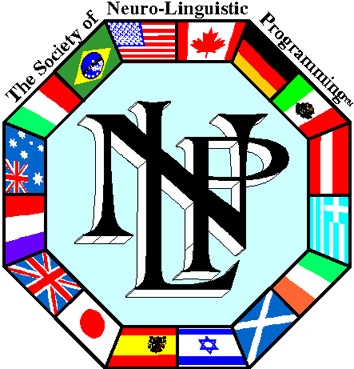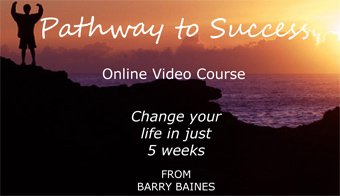Spatial anchoring
NLP secret
In addition to reading this article on spatial anchoring, may I suggest that you also read those other website pages that deal with anchoring: NLP anchoring and Explaining NLP anchors.

The reason people have problems is that they have too much time to think
Richard Bandler
Can’t get going?
Sometimes people have a notion that they want to make something happen in their lives but they just don’t seem to be able to manage it.
Somehow they can’t get their project off the ground.
So many seem to sit around talking about it, going through the motions of planning but not actually taking the action that enables them to go through with their plans.
How often have you thought that you might like to learn a musical instrument or a new sport, perhaps train for a different career?
Then you’ve read about it, mused about it, discussed it with family and friends, a couple of years go by, still nothing has happened and you begin to talk yourself out of it.
If you really want to do something, now is the time to take action.
Time will pass anyway so you had just as well get on with it.
Don’t wait for the perfect time because I can assure you it will never come.
Spatial anchoring and Emma’s goals
This is the state of mind Emma was in when she consulted me.
She had been attempting to write her first novel for a long time but never seriously tackled it.
I started the conversation by talking a little about goals and it was evident before very long at all that Emma had not previously set goals and neither had she considered planning her life in that way.
It was important that Emma thought about her goals and how she would turn them into her desired outcome.
Spatial anchoring and SMART objectives
I asked her to be specific. For example, what sort of novel did she want to write?
Was the plot in the present time? Or was it a historic novel?
Or was it sci-fi? Or was it something entirely different?
Was this to be a novel for children, teenagers or adults.
For what group or section of society was she aiming specifically?
Emma soon got the idea and, with gentle probing from me, she was able to get a clearer picture in her mind of what she wanted to achieve.
Next I wanted to know how she would measure her achievement.

Would Emma, for example, consider that she had achieved her objective when she had written a novel length story to her satisfaction?
Or did she mean that she would have to draft and redraft, get an agent to accept her as a worthwhile client, and seek a reputable publisher?
Perhaps Emma would not consider that she had succeeded unless she made it to the best seller charts.
These were questions only she could answer but which needed to be addressed.
Thirdly, I wanted to know if the goal was attainable.
Emma was English. What was her general standard of writing like?
Could she spell and punctuate soundly? Could she tell a compelling story in a coherent way?
Was she a published writer in any other respect (for example, had she written newspaper or magazine articles?)
Another important question that people sometimes fail to address is whether they need any further training before they attempt their main goal, so we talked about that too.
In the light of what we had discussed already, I then asked Emma if she felt her goal was realistic.
I also wanted to know if she would find it rewarding (not necessarily in the financial sense).
Would Emma be able to fit in her writing with her other commitments of raising a family and working part-time?
How exactly would she do that?
Spatial anchoring and a well-formed outcome
Finally, we talked about setting a timetable for her writing. These are what we call the SMART objectives, only briefly explained here, for a well-formed outcome.
Spotlighting or spatial anchoring
Once all that was very clear in Emma’s mind and she had made suitable notes I showed her how to use spotlighting which is a type of spatial anchoring to assist her with her writing.
I asked her to recall a strong and positive memory that she knew would propel her into action and that she could see through her own eyes.
She concentrated on the various modalities and sub modalities in turn and intensified her experience.
I had deliberately arranged this consultation in Emma’s home in the very room she intended to write, and I asked her at this stage to imagine a spotlight forming a circle on the floor, to step into that circle and recreate the motivational feeling.
Then I asked her to step out of it and we talked about something else for a moment to break state.
Emma then repeated the exercise on two more occasions to strengthen the anchor.
Afterwards she fired the anchor to test it. Now each time she goes into the room to write Emma starts the session by stepping into the circle, thus firing her anchor and incentivising herself.

Spatial anchoring and used of the time line
For the conclusion of this consultation, I utilised the timeline technique to underpin her goals and ensure, as far as possible, that they were realised to Emma’s satisfaction.
By this stage Emma had a well-formed goal in mind and I asked her to close her eyes and reinforce that by imagining what she would see once it was achieved.
How would she feel? What would she hear? What might she taste and smell?
Once again I got her to intensify that picture in her mind, see herself holding it and imagining the outcome.
Then Emma imagined her timeline stretching out into the future and seeing precisely where her goal lay.
In her mind’s eye she attached a thread to her body at one end and to her goal at the other.
Then Emma mentally walked along her time line until she reached the place where her goal was achieved and felt it slot into place.
At this stage I asked Emma to keep the thread in its place but to turn and walk back along her time line to the present but I said to her:
You are to walk back along your time line to the present time but only as fast as your unconscious mind can make all the adjustments needed to take you easily to your desired goal.
When Emma indicated to me that she was back in the present moment, I asked her to look forward along her timeline and see her achieving her outcome.
I knew by the smile on her face that she could see it clearly and now was the time to bring her out of trance.
Below there is a list of further NLP techniques or secrets that you may wish to refer to:
- Anchors
- Anchors Explained
- Association and Dissociation
- Body Language Signs
- Body Language, How to read
- Building Rapport
- Embedded Commands
- Godiva Chocolate
- Modelling
- Modelling Genius
- Modelling helped me
- NLP Language Patterns - Deletion
- NLP Language Patterns - Distortion
- NLP Language Patterns - Generalisations
- NLP Language Patterns - The Meta Model
- NLP Language Patterns - Towards and Away
- Pacing and Leading
- Perceptual positions
- Reframing
- Spatial anchoring
- States
- (Changing) States
- Sub modalities
- Swish Pattern
- Visualisation
Gain FREE access to my self-confidence video
To gain free access to my self-confidence video enter your email address and first name in the box below. This will also keep you up-to-date with my free newsletter Inspirations.
As a bonus for subscribing you'll receive the first three chapters of my book Towards Success, where you can learn more about NLP techniques, from Anchors to Modelling, and my 50 favourite inspirational quotations.
Return from Spatial anchoring to
The Secret of Mindpower and NLP Home
Return to Site Search & Contents Page

Change your life in just 5 weeks
Discover the pathway to success with my online video course. Learn more

Download NEW ebook Your Genius Within and find out how to uncover your own inner genius

NLP Articles
- Anchors
- Anchors explained
- Anger Management tips
- Anxiety Panic Attacks
- Beating disappointment
- Beating drug addiction
- Best self-help book
- Big events
- Body control module
- Body language attraction
- Body language flirting
- Body language in communication
- Body language interpretation
- Body language of a liar
- Body language signs
- Boost self-confidence
- Building Rapport
- Changing bad habits
- Changing beliefs
- Changing States
- Children
- Christmas (Holidays)
- Christmas & New Year greetings
- Chronic pain management
- Conquering Fear
- Crohn's Disease
- Cure for a Phobia
- Deal with your fear
- Deletion
- Determining your destiny
- Developing your senses
- Disaster to Triumph
- Distortion
- Drawing the line
- Embedded Commands
- Enthusiasm
- Exams
- Expecting the Best
- Expert Relationship Advice
- Eye accessing cues
- Fear of driving
- Fear of elevators
- Fear of flying
- Fear of the dentist
- Fear of vomiting
- Fear, Mental Blocks & Hesitation
- Fear, Uncertainty and Doubt
- Fight or flight response
- Finding Solutions
- Forever Worried?
- Friendly persuasion
- Generalisation
- Get the life you want
- Getting lucky
- Getting over your past
- Goal Setting Tips
- Goal Setting Tools
- Goal Setting Tools, More
- Great self-help books
- Grief
- Happy retirement
- Healthy Mind
- High blood pressure
- How long will I live?
- How to be lucky
- How to read body language
- Hypnosis & NLP
- Hypochondria
- Imagining perfect performance
- Improving speed reading
- Instant Mood Lift
- Interviews
- Knowing yourself
- Learn NLP
- Life Values
- Maintaining weight loss
- Make you thin
- Making it happen
- Managing change
- Meddling Mom
- Meeting People
- Mental rehearsal techniques
- Meta Model
- Metaphor
- Modelling
- Modelling Genius
- More NLP techniques for weight loss
- NLP Books
- NLP Courses
- NLP Practitioner Course
- NLP Master Practitioner Course
- NLP Secret
- NLP jargon buster
- NLP Modelling helped me
- OCD symptoms
- OCD treatment
- Overcoming low self-esteem
- Overcoming stage fright
- Pacing & Leading
- Persuasion
- Presuppositions
- Presuppositions (2)
- Problem solving
- Public Speaking
- Reaching agreement
- Reframing
- Self-confidence
- Self limiting beliefs
- Self-image
- Sportsmen Guide
- Stage fright tips
- Stammering
- States
- Stop binge eating
- Stop Smoking
- Subliminal Persuasion
- Success Principles
- Techniques for persuasion
- Techniques for weight loss
- The meaning of NLP
- Time & NLP
- Towards
- Towards & Away
- Ulcerative colitis
- Weight Loss
- Weight loss techniques
Articles on HYPNOSIS:
- Big events
- Conversational Hypnosis
- Covert hypnosis
- Deepening self-hypnosis
- Depression Hypnosis
- Handshake interrupt
- How to do self-hypnosis
- How to hypnotise your audience
- Hypnosis and Weight Loss
- Hypnosis NLP
- Hypnosis: Right or Wrong
- Hypnosis Stories
- Hypnotic language
- Hypnotism Stories
- Hypnosis story for you
- Hypnosis to quit smoking
- Instant self-hypnosis (age regression)
- Practical self-hypnosis
- Self-Hypnosis
- The Milton Model
Articles about THE SECRET of:
- Abundance Mentality
- Achieving more
- Beating Domestic Violence
- Being bothered
- Being Happy
- Best Self-help Book
- Conquering road rage
- Coping with criticism
- Dealing with pride
- Defeating stress
- Discover the secret of wealth
- Genius
- Getting off to sleep
- Getting over a break up
- Getting over your temper tantrum
- Health
- How to deal with grief
- Imagination
- Influence
- Love
- Making Money
- Managing others
- Memorising a Deck of Cards
- Memory
- My Success
- Organising Memory
- Overcoming tiredness
- Overcoming worry
- Perpetual energy
- Remembering
- Secret Law of Attraction books
- Sleeping well
- Speed Reading
- Super Memory
- Surviving a recession
- Surviving negativity
- The Secret Law of Attraction
- Towards
- Teachers of the Secret
- Waiting for God
- Wealth Building
- Weight Loss
Articles about COACHING:
- Barriers to effective communication
- Communication
- Executive Business Coaching
- Feedback
- Free interview tips
- Free Life Coaching
- Goal Setting Tips
- Goal Setting Tools
- Goal Setting Tools, More
- Life & Executive Coaching
- Personal Development Plan
- Problem solving
- Success Principles
- The Secret of my Success
- Time Management
Articles on GENIUS and MIND POWERS:
- Activating genius
- Become a genius
- How long will I live?
- Mind Powers
- Misty Reflections
- Modelling Genius
- The Secret of Genius
Articles about MEMORY:
Articles about RELATIONSHIPS:
- Beating domestic violence
- Body language flirting
- Expert relationship advice
- Healthy family relationships
- Hurt feelings
- Love
- Relationship problem advice
- Signs of true love
- The secret of getting over a break up
Articles on WEALTH:
Articles on WEIGHT LOSS:
- Best Weight Loss Plan
- Body control module
- Easy weight loss
- Hypnosis and Weight Loss
- Maintaining weight loss
- More NLP techniques for weight loss
- NLP techniques for weight loss
- NLP techniques to make you Thin
- NLP weight loss techniques
- Stop binge eating
- The Secret of weight loss
- Weight control help
- Weight loss tips
- Why have I lost weight?
Real Women of Genius Articles:
Real Men of Genius Articles:
- Abraham Lincoln
- Albert Einstein
- Antoni Gaudi
- Carl Jung
- Charles Darwin
- Charles Dickens
- Christopher Wren
- Confucius
- George Washington
- Hannibal
- Horatio Nelson
- Isaac Newton
- Julius Caesar
- Lawrence of Arabia
- Leonardo da Vinci
- Michelangelo
- Mohatma Gandhi
- Napoleon Bonaparte
- Nicolas Copernicus
- Oscar Wilde
- Rembrandt
- Robert Burns
- R L Stevenson
- Socrates
- Walt Disney
- William Shakespeare
- Wolfgang Amadeus Mozart








New! Comments
Have your say about what you just read! Leave me a comment in the box below.